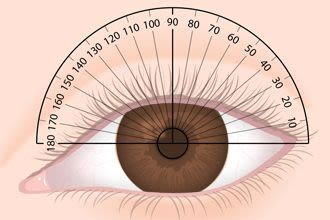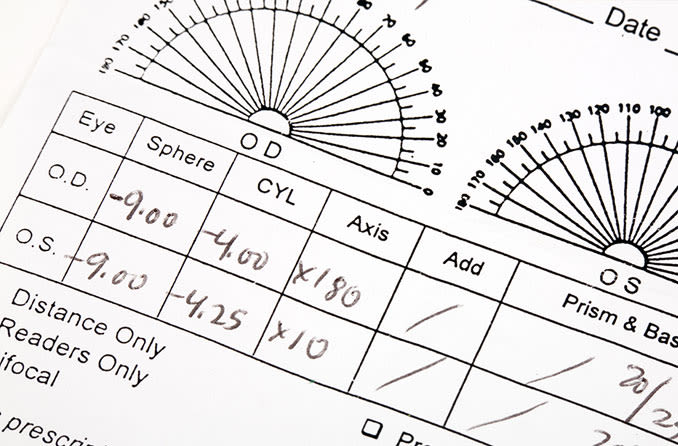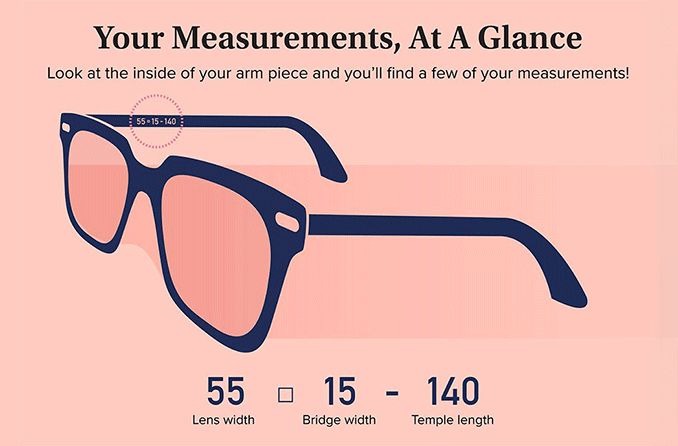Sphere (SPH)
Sphere indicates the amount of lens power prescribed to correct nearsightedness or farsightedness. Lens power, or prescription strength, is written in diopters (D):
- If the number under this heading has a minus sign (-), you are nearsighted.
- If the number under this heading has a plus sign (+), you are farsighted.
Prescriptions are stronger the further away this number is from zero.
The term "sphere" means that the correction for nearsightedness or farsightedness is "spherical," or equal in all meridians of the eye. Meridians are imaginary lines of focusing power that run through the eye, similar to the longitudinal lines on a globe.
Cylinder (CYL)
Cylinder indicates the amount of lens power required to correct astigmatism. It typically comes after the sphere power on an eyeglass prescription.
The number in the cylinder column may have a minus sign (for the correction of nearsighted astigmatism) or a plus sign (for farsighted astigmatism).
If nothing appears in this column, it means you either don’t have astigmatism or your astigmatism is so minor that it doesn’t need correction.
Unlike a spherical lens, a cylindrical lens has a different strength (focusing power) in each meridian. One meridian contains a lower strength and the meridian 90 degrees away has the higher strength.
Cylinder is created by varying the curvature of the lens surface, just like a football has different curvatures, including a flat and steep curve.
Axis
Axis represents the location of the astigmatism on the cornea (the clear, dome-shaped structure at the front of the eye that helps focus light so you can see). This number is listed on the prescription in degrees. It shows the orientation of the cylindrical correction. Just like a football can be placed in different positions (for example resting on its steep side, flat side or somewhere in between).
Whenever an eyeglass prescription includes cylinder power, it should also include an axis value, which is listed after the cylinder power.

The meridians are determined by superimposing a protractor scale on the eye's front surface.
The axis is defined with a number between 1 and 180:
- The number 90 corresponds to the vertical meridian of the eye.
- The number 180 corresponds to the horizontal meridian of the eye.
Imagine that the astigmatism is similar to the curves of a football, and the axis is the orientation of the football.
Add
“Add” is the added focusing power applied to the bottom part of multifocal lenses to correct presbyopia. This vision condition affects the eye’s natural crystalline lens, reducing its ability to change shape and focus on nearby objects. Presbyopia typically begins around age 40.
The number appearing in this section of the prescription is always a "plus" power, even when you don’t see a plus sign. It generally ranges from +0.75 D to +3.00 D and will be the same for both eyes.
Prism
This is the amount of prismatic power prescribed to compensate for diplopia (double vision) caused by eye alignment problems. It’s measured in prism diopters, which may be listed as "p.d." or a triangle when written freehand.
Only a small percentage of eyeglass prescriptions include a prism measurement.
When present, the amount of prism is written in either metric or fractional English units (such as 0.5 or ½). The direction of the prism is indicated by noting the relative position of its "base" (the thickest edge).
Four abbreviations represent the prism directions:
- BU (base up)
- BD (base down)
- BI (base in, toward the wearer's nose)
- BO (base out, toward the wearer's ear)
Pupillary distance
Pupillary distance refers to the amount of space from one pupil’s center to the other pupil’s center. It’s measured in millimeters (mm) and is sometimes abbreviated as “PD.”
This measurement ensures that the optical center of each eyeglass lens aligns with the corresponding pupil correctly, which is necessary for clear, comfortable vision.
Pupillary distance isn’t always included on eyeglass prescriptions. While some states require this measurement to be listed, most do not.
Vertex distance
While not required, some prescriptions have a section for "vertex distance." This is the distance from the back surface of the corrective lens to the front surface of the eye (the cornea).
Any changes in vertex distance can impact the effectiveness of your lenses. For example, if your glasses slide down your nose, you may not be able to see as clearly as when your glasses are positioned properly.
The vertex distance (VD) is usually around 12 millimeters for eyeglasses. The VD for contact lenses is 0 millimeters because they rest directly on the eye. You can’t use the same prescription for glasses and contacts because the VD for one is so different from the other.
How they're measured
Sphere power, cylinder power and add power always appear in diopters. They’re expressed in decimal form and are generally written in quarter-diopter (0.25 D) increments.
Axis values are whole numbers from 1 to 180 and signify only a meridional location, not a power.
When prism diopters are indicated in decimal form, only one digit typically appears after the period (for example, 0.5).
An example eye prescription chart
To make it easier to understand how to read an eye prescription, let’s review an example.
For the right eye (OD), an eye doctor prescribed the following:
- -2.00 D sphere for the correction of nearsightedness.
- No cylinder power or axis, which means no astigmatism is present. This doctor chose to write "SPH" to confirm that the right eye is being prescribed only spherical power. Some doctors will add "DS" for "diopters sphere," and others will leave it blank.
The left eye (OS) was prescribed:
- -1.00 D sphere for nearsightedness correction.
- -0.50 D cylinder for the correction of astigmatism.
- A cylindrical power with an axis at the 180 meridian. This means that the horizontal (180-degree) meridian of the eye has no added power for astigmatism, and the vertical (90-degree) meridian gets the added -0.50 D from the cylinder column.
Both eyes were prescribed:
- An "add power" of +2.00 D for the correction of presbyopia.
- Prismatic correction of 0.5 prism diopter in each eye. In the right eye, the prism is base down (BD). In the left eye, it's base up (BU).
The final prescription would look something like this:
Eyeglass Rx | Sphere (SPH) | Cylinder (CYL) | Axis | Add | Prism |
Right (OD) | -2.00 | SPH | | +2.00 | 0.5 BD |
Left (OS) | -1.00 | -0.50 | 180 | +2.00 | 0.5 BU |
Pupillary distance (PD) | | 63 | Vertex distance (VD) | | 12 |
SEE RELATED: How “bad” is my prescription?
Can eyeglass prescriptions be used to buy contact lenses?
No, you cannot use your glasses prescription to buy contact lenses.
An eyeglass prescription only works for the purchase of eyeglasses. It does not contain certain information that is crucial to a contact lens prescription.
That information can only be obtained through a contact lens fitting, an additional procedure that can be performed during your eye doctor visit.

Contacts rest directly on the eye’s surface, while eyeglass lenses sit a short distance away (usually about 12 millimeters). This is the vertex distance, which affects the lens power required for the eyes to focus properly. Therefore, the power of an eyeglass prescription is often different from the prescribed contact lens power.
In addition to the information in an eyeglass prescription, a contact lens prescription must specify:
- The base (central) curve of the back surface of the contact lens
- The lens diameter
- The specific manufacturer and brand name of the lens
An accurate contact lens prescription can be written only after a contact lens fitting has been performed. During this appointment, you’ll try on different contacts and your eye doctor will evaluate how your eyes respond to the lenses. They’ll also assess your candidacy for wearing contacts in general.
SEE ALSO: Contact lens vs. eyeglasses prescriptions
Do eye prescriptions expire?
Yes, eyeglass prescriptions expire, and the expiration date is often included on an eye prescription.
While the exact timeframe differs by state and individual needs, eye prescriptions are typically valid for one to two years.
Your eyeglass prescription is yours to keep
The Federal Trade Commission (FTC) is the U.S. government's consumer protection agency. Its Eyeglass Rule requires that eye doctors give patients a copy of their eyeglass prescription at the end of an eye exam that includes a refraction (a test used to determine the lens prescription).
The Eyeglass Rule enables the "portability" of your eyeglass prescription. It gives you the freedom to buy glasses from any retailer of your choice.
Your eye doctor must give you a copy of the prescription, whether or not you ask for it. Eye doctors may not condition the release of your prescription on your agreement to purchase eyeglasses from them, nor may they charge you an extra fee to receive your prescription.













